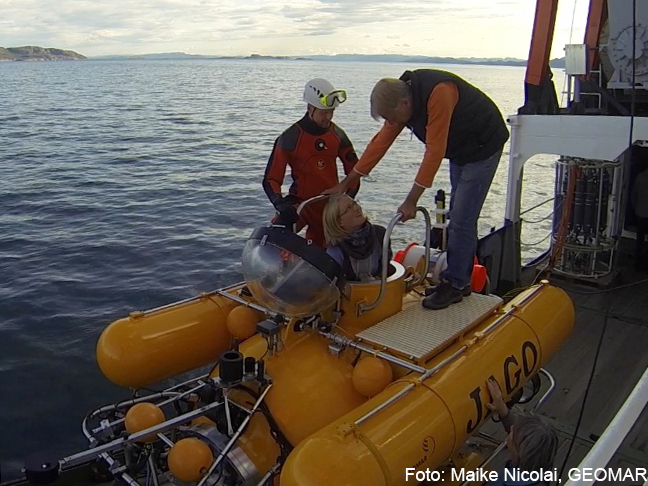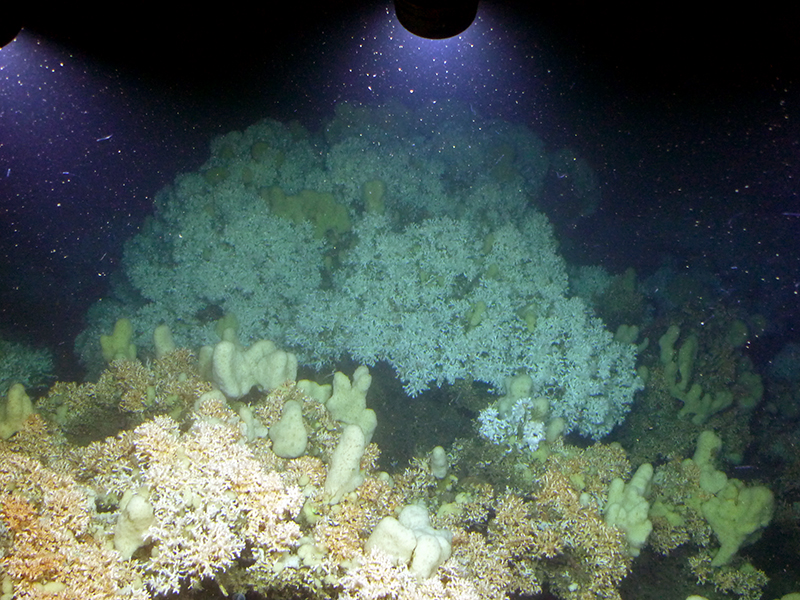Documenting the reef
(deutsche Version unten)
The aim of my dive was to collect video material of the reef top to document occurrences of corals, sponges and other organisms as part of my PhD work. This may sound like a simple task. But at this reef we’ve encountered very strong currents that often made dives to the reef top impossible. During one of last year’s dives JAGO pilot Jürgen Schauer and I were stuck in the coral rubble area for a couple of hours and couldn’t move upslope towards the reef due to currents coming down at JAGO like a waterfall.
Asking for our position after descending to the seafloor this time, we had to realize that the currents moved us some 100 meters away from the reef. We were half expecting to watch the sediment in front of the window for the next hours – but not this time. As predicted by tidal charts the currents weakened quickly and we could approach the reef without any difficulties. When we reached the reef top there was nearly no water movement. We were able to document massive living Lophelia blocks resembling enormous cauliflowers – in white and orange. Large sponge communities were sitting on top of the reef and some huge soft corals where thriving between the Lophelia colonies. Due to a perfectly working navigation system and little water movement we were able to cross the reef at a slow speed, collecting amazing video footage of the whole reef top. This dive was scientifically and personally a unique experience.
Swaantje Bennecke
Riff-Doku
Ziel meines Tauchgangs war es, Korallen, Schwämme und andere Organismen auf dem Riffdach für meine Doktorarbeit zu dokumentieren. Das klingt zunächst nach einer einfachen Aufgabe. Doch an diesem Riff gibt es starke Strömungen, vor denen es auf dem Riffdach keinen Schutz gibt. Während eines Tauchgangs im vergangenen Jahr saßen JAGO-Pilot Jürgen Schauer und ich mehrere Stunden unterhalb des Riffes im Sediment fest, weil wasserfallartige Strömungen von oben ein Weiterkommen unmöglich machten.
Als wir diesmal nach Abstieg in die Tiefe bei der Landung am Boden unsere Position abfragten und die Botschaft bekamen, einige hundert Meter verdriftet worden zu sein, malten Jürgen und ich uns wieder muntere Stunden im Tiefseesediment aus. Doch dieses Mal kam es anders. Wie von Gezeitentabellen für diese Region vorhergesagt, nahmen die Strömungen während des Tauchgangs schnell ab. So konnten wir ohne große Umwege ans Riff gelangen. Ganz oben bot sich uns ein großartiger Ausblick auf riesige Lophelia-Ansammlungen, die wie massiver Blumenkohl dort wachsen.
Neben den weißen Kolonien konnten wir auch einige orangefarbene Korallenblöcke dokumentieren, die zusammen mit großen rosafarbenen Weichkorallen und gelben Schwämmen für ein paar Farbtupfer sorgen. Da sowohl die Tauchboot-Navigation als auch die Strömungen in unserem Sinne arbeiteten, war es möglich, bei langsamer Geschwindigkeit fantastisches Videomaterial des Riffdaches zu sammeln. Dieser Tauchgang war wissenschaftlich und persönlich ein einmaliges Erlebnis.
Swaantje Bennecke

